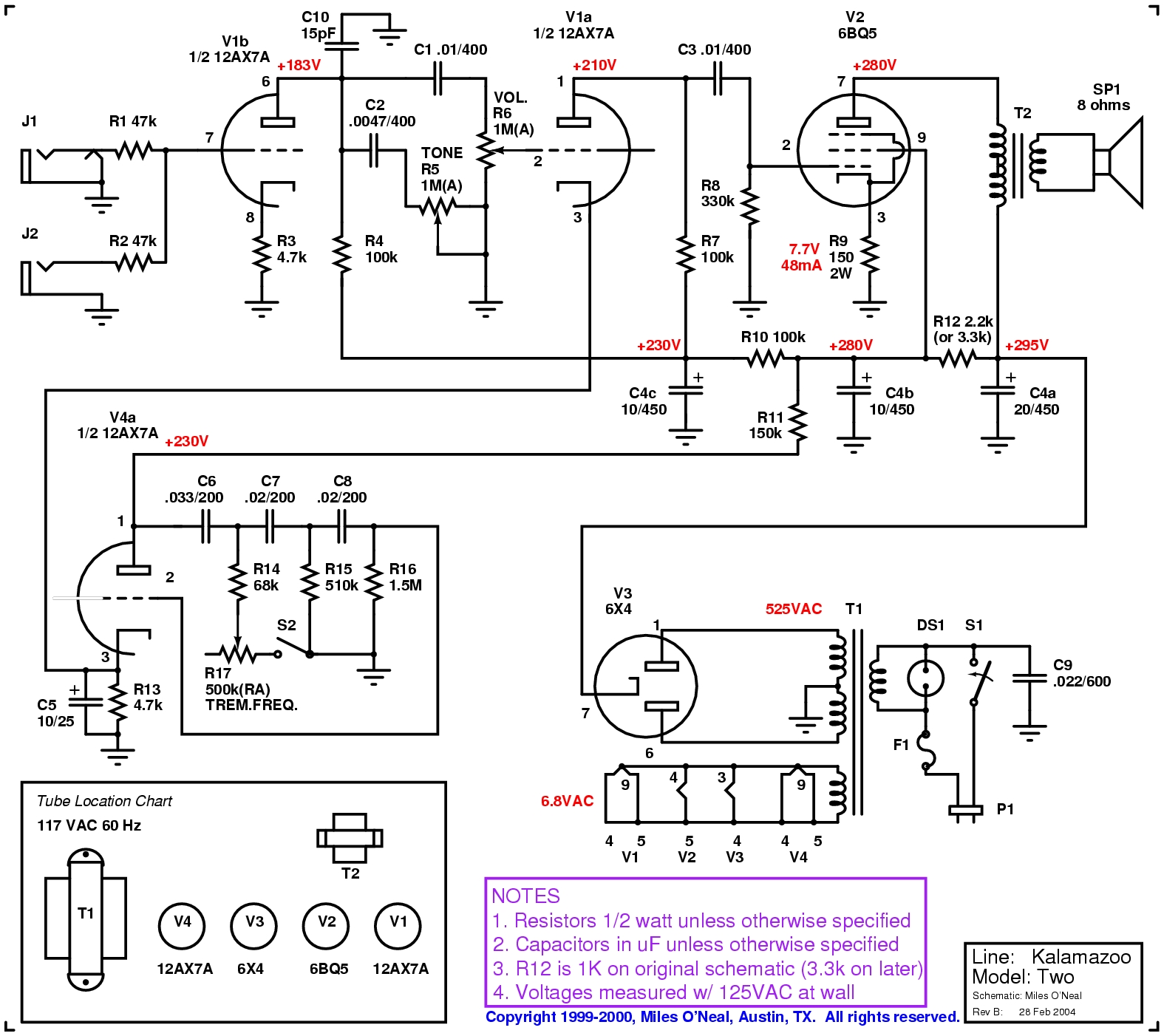I have a Kalamazoo Model 2, which is a great little 10 watt tube amp. It's been good so far, but recently it's been noisy. It's not a buzz or a hum that comes out, but it's just noise, kind of like when you turn the radio dial and it isn't on a particular station. This happens about half the time I have it on, and it can get pretty loud. I've tried to isolate the problem, and I've found this:
- it's not affected by volume, therefore it's probably after the volume stage
- it is affected by the tremelo, so it's before the tremelo stage
- it's still there whether or not the tremelo is on, so therefore it has to be before the tremelo stage
It has four tubes, but the only one that is in between the volume and the tremelo circuit is the 6BQ5 output tube. You can find the schematic for the amp here: 
The only idea I've been able to come up with is that the output tube is loose. However, I'm no amp technician, let alone electrician, so I know nothing about this stuff. Hopefully some of you do :wink:
Thanks.
well I do know that that noise your hearing is called "white noise". anyway, I havnt fixed ay tube amps so I probably can't help but I do somewhat understand the schematics (Going for technician amatuer radio license in sept!). If no one else can help I wuold suggest either fiddling with the tupe if its loose or replacing it but don't hold me to it just a suggestion.
bstguitarist
:lol:
There comes a time in all good 1966 tube amps when tubes and capacitors need to be changed. Without testing it this will just be a couple things to consider. I would re-tube it first. then consider having new capacitors installed. When Capacitor's start leaking the can create an imbalance in the flow which will do funny things. Maybe look for any loose wires or if a wire is touching something it shouldn't.
" Think Safety "
Here's an Idea what the Tubes will cost.
you'll need 2..12ax7's and 1 each of the others.
12ax7... PREAMP around 7.00 to 15.00
6x4...FULL WAVE RECTIFIER 5.95
6BQ5-EL84 POWER AMPLIFIER TRIODE 8.00
Just thinking.
Joe
Thanks bstguitarist and forrok_star. I've tried adjusting the tube, and since then I haven't had any noise. :D I don't know if it'll come back though. I think the amp has had new capacitors put in, but I don't know about the tubes. Luckily, those tubes seem relatively cheap. I was looking online and some of them are $100! I have a few questions on tubes though. Would I have to re-bias my amp if I re-tubed it? Also, could I change tubes to get different sounds (i.e. a EL84 to a EL34 or 6V6?). Would I want to? Thanks.
That depends but should at least be checked when new tubes are installed then about a month or two after they break-in. Most configurations, the vacuum tubes need a negative bias on the control grid. So most tubes are built for an operating range with a negative grid bias of several volts. This means that our equipment really needs three supply voltages: A low voltage for filament power (possibly AC), a positive voltage (B+) in the order of 50-350V for plate power, and a negative voltage (B-) in the order of 6-20V for grid bias.
"Self biasing", the simplest way to do that is to insert a resistor in series with the cathode. The current flowing through the tube will now create a voltage drop over the resistor and with the grid referenced to zero, the tube will be properly biased. You'll need matched sets of tubes.
" Adjustable ", You'll see variable individual trimmers that are used to adjust each output tube's bias voltage. It is like setting the idle on your car. Individual bias trims eliminate the need for expensive matched sets of tubes.
This also depends on the amp. There are adapters you can get called yellow jacks that will allow you this for the output tubes. preamp tube are a whole different animal. I was looking for my list but can find it at the moment. Your best bet with an amp that old is to leave original you start shotgunning it and the transformers can start having problems. They may or may not be something you'll easily find. Expensive prehaps too.
Joe


